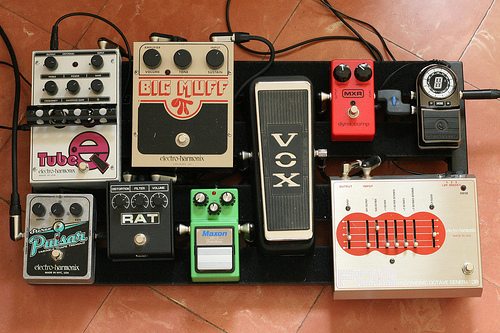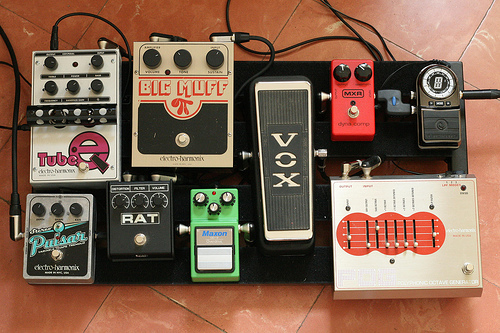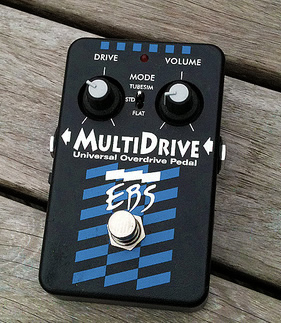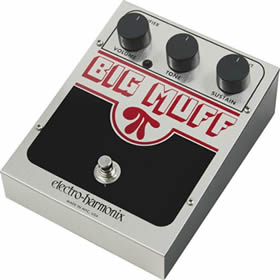Traditionally, bass players didn’t use as many effects as guitarists, but I’m on a mission to change all that.
Used badly, bass effects can render your tone unsubtle and tiring to listen to, and result in you being totally lost in the mix. But use them well and you can achieve sonic nirvana and create brave new bass tones of your very own.
I think much of the bad rap comes from the terrible mess that guitar effects can make of a bass signal, but specialist bass manufacturers now make superb ranges of pedals, turning all that tradition on its head.
Boom and Bust
The place to start, before applying any effects, is your EQ. Setting the bass, mid and treble balance on your bass itself (or your amplifier) gives you control of the trade-off between articulation and low-end thump which is always key to a good bass tone. For example, dub bass calls for a thick, gloopy, neck pickup tone that will flap the bass bins and get the reggae girls bogling.
Players who favor high-register melodic or chording approach, like Chris Squire of the band Yes require a toppy sound without too much low end getting in the way of the speedy runs.
In this example I play a Sting style dub reggae riff with a dub tone, and then with a trebley tone
In the second example, I play an intricate and fast Chris Squire-style riff first with the dub tone, and then again with the trebly tone
As you can hear from that example, each tone suits a particular style of playing. There is no bass tone magic bullet!
Squish
Many bassists use a compressor or limiter. Unlike with guitar, which uses these to increase sustain and make picking sounds clean and level, on bass it is normally used to tame the percussion-like peaks that result from slap techniques.
A compressor (more precisely called a “dynamic range compressor”) is a device that reduces the difference between the loudest and quietest sounds the bass can produce.
The first compressor came out of the days when engineers recorded sound by directly cutting into a disc with lathe. Too much bass would make the blade gouge into the master and ruin the recording, so someone invented the compressor to even out the levels. Wily producers soon realized that a fat, punchy sound came with compression, and since that sound—coming from a jukebox—turned heads, they started using it as part of their sonic pallete.
The fatness that compression adds is certainly an advantage for bass players, but it offers other benefits as well:
- Compression can even out playing dynamics, which, as well as hiding a multitude of sins caused by sloppy technique is especially useful when changing among finger-style, slap, and pick bass, since each playing technique differs significantly in volume.
- More expensive compressors may have a so-called “multiband” feature. This assigns different compression levels to different frequency bands meaning you can tame the percussive top end of slap bass without losing the fatness of the low end.
- Compression is so ubiquitous among bass players that manufacturers often build it into bass amps the way they build reverb into guitar amps. Another term for a compressor built exclusively for stopping the bass from overloading the preamplifier is “limiter.” Even though you cannot adjust these to precisely shape your tone, they are fundamentally the same audio effect.
In the example below a series of notes are played using a plectrum with deliberately uneven dynamics. The same notes are then repeated with heavy compression. Notice how the compressed notes are all at the same level but you can still hear the difference in the attack of the plectrum as the picking becomes more aggressive.
Compression can also have the unintended effect of raising the level of background noise. Listen for the added hiss in the second example.
You can learn more about dynamic range compressors in our Hearing Effects series.
Dirty Sexy Bass
Bass players like a bit of filth as much as the next man (unless of course the next man is Russell Brand, but I digress). The unfortunate side effect of applying a regular overdrive sound to bass is a loose and woolly low end, or worse, no low end at all!
The pros get around this by using two bass amps with one running clean, or by bi-amping (passing the signal to two amps by way of a frequency splitter) so that only the high end is affected. Specialist bass effect manufacturers know that the average Joe can’t afford two bass amps, and so many bass-centric pedals now offer features that allow either the bass frequencies to pass unmolested, or to mix some of the clean sound back into the output.
The following example demonstrates an aggressive rock pick-bass riff first clean, then with an unfiltered overdrive engaged (which creates a muddy sound), and finally the same riff with the addition of an overdrive with some lowpass-filtered clean signal blended in. For this example, I used an EBS Multidrive pedal.
Superfuzz Bigmuff
Sometimes dirt isn’t enough, you need susssssssssstaaaaaaaaaaaaaainnnnn.
Fuzz pedals allow bass players to reach new sonic territories with near-infinite sustain and an almost complete lack of dynamics, which gives a brutal sound not unlike an analogue synthesizer. The Electro Harmonix Big Muff is the most popular fuzz pedal among bass players because of its smooth tone and tight bass response. Recent models allow you to blend in a clean tone if you want.
Chris Wolstenholme of the band Muse has popularised fuzz-tone bass recently. Chris Wolstenholme of the band Muse. Many of Muse’s biggest hits are based around aggressive fuzz bass riffs pushed to the front of the mix.
The following sample is an aggressive bass riff in the style of Muse—played first clean, then with fuzz, and finally with fuzz blended with clean signal.
Bassists often use the sustain of heavy fuzz to emulate synth parts. You can enhance this effect by adding a triggered filter pedal.
In this example, I enhance a synth-like riff with fuzz and then with an Electro Harmonix Bass Balls filter pedal.
First the bass plays a synth-style riff clean. Then again, with fuzz. The third time around a Bass Balls filter pedal is added, and then an analogue delay set to feedback to produce some Dr. Who-style swoops.
That should give you a sense of the wide variety of tone possible with the electric bass. Next time we’ll be taking it even further, looking at modulation effects and other tone modifications co-opted from the world of guitar!
Which effects have you found are best suited to bass? Have you found a magic combination to give you your dream tone? Or produced a hideous mess which should never be inflicted on unsuspecting ears? Tell us your bass FX tales of glory or disaster in the comments below!












cool stuff man, hope to see more.
Cheers fella
The podcast of part two should has just been released: https://www.musical-u.com/learn/bass-tone-podcast-6-bass-fx-part-2/
Let me know if there is anything you would like me to cover in future.
Yes, unlike traditional bassists I do like to use bass guitar effects. Brings about a new flavor and I don't find any wrong trying out new styles and sounds. After all it's all about making your mark and playing a nice piece that catches your imagination.
Absolutely – sounds like you have your priorities straight!
Which effects do you use to achieve your own bass tone?